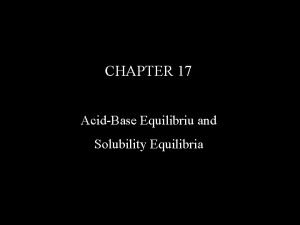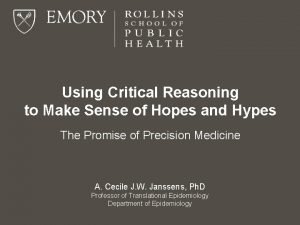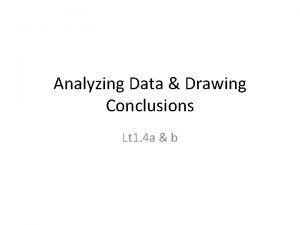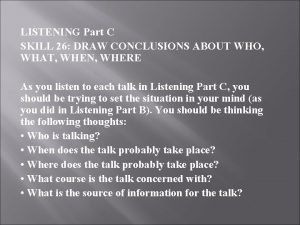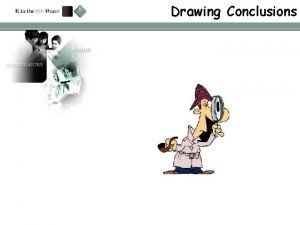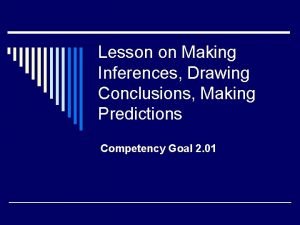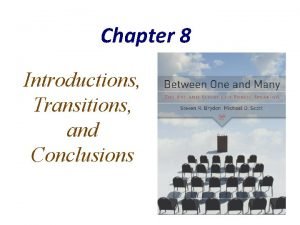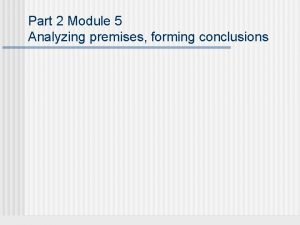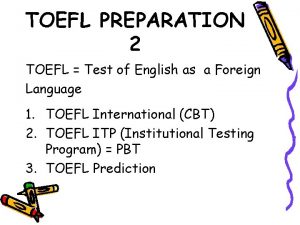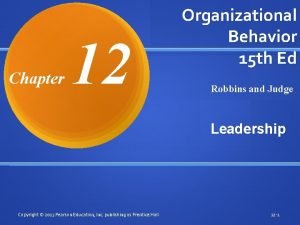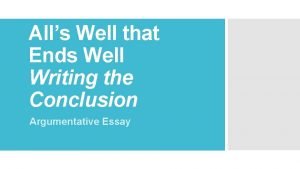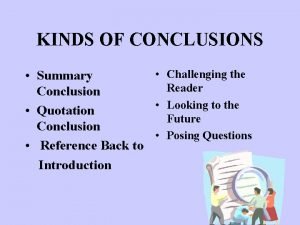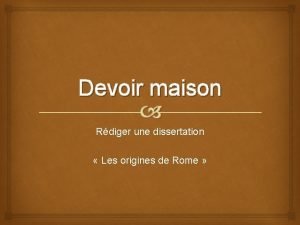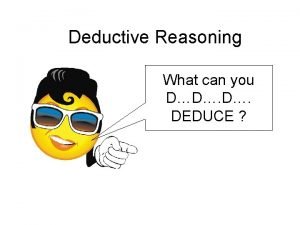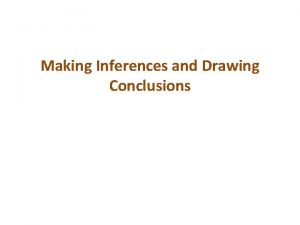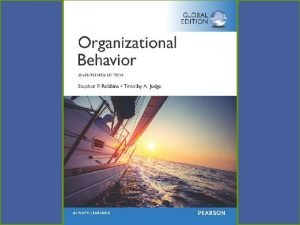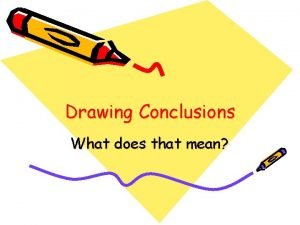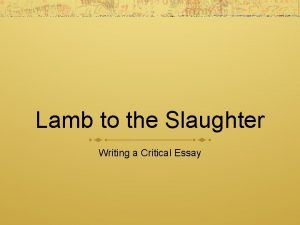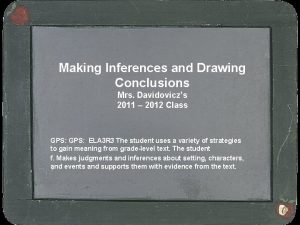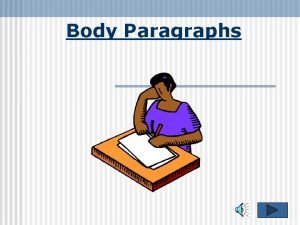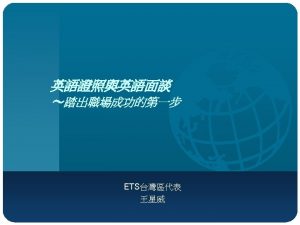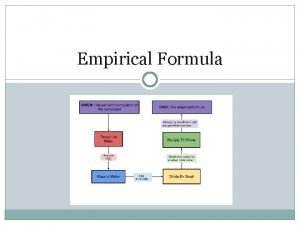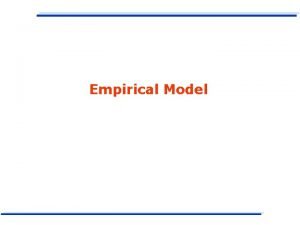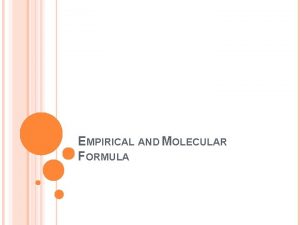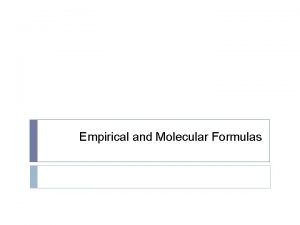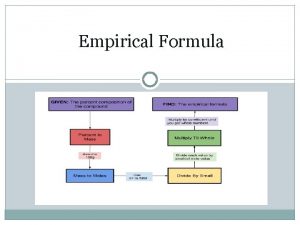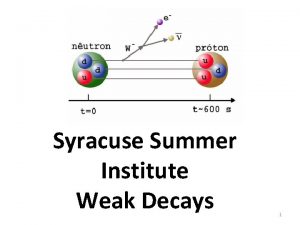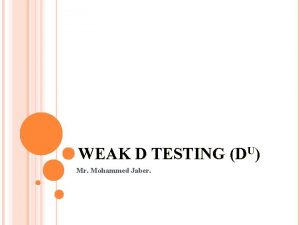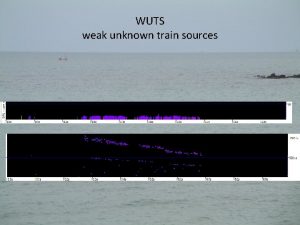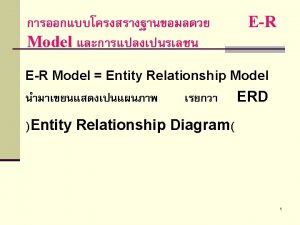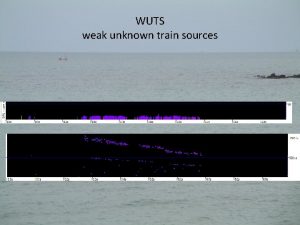Conclusions Regarding Empirical Support Weak empirical support If



























- Slides: 27

Conclusions Regarding Empirical Support • Weak empirical support • If anything, the certainty of punishment may have marginal effects on crime • WHY SO WEAK? • Based on “weak” theory—weak assumptions • Limits of deterrence in a democratic society • MARGINAL vs. ABSOLUTE 1

Informal Sanctions • Fear of Informal Sanctions is not “Deterrence theory. ” • Deterrence derived from classical school (legal reform) • Informal social control theory (To be Discussed) • However, formal sanctions may “kick in” informal sanctions. 2

Policy Implications of Deterrence • Rehabilitation, (unless painful) won’t work, and may “send the wrong message” • Raising the certainty, swiftness or severity of criminal penalties will work • If system cannot be swift, severe and certain enough, then reduce opportunities for offending • Incapacitation 3

Neo Classical Theory Part II Rational Choice Theory Routine Activities Theory Situational Crime Prevention

“Rational Choice Theory” • Economics (language, theory) • “Expected Utility” = calculation of all risks and rewards • This is much broader than deterrence • Includes risks not associated with criminal justice • Same core assumption as deterrence theory • Human nature = rational, calculating, hedonistic • This is because “economic theory” (supply/demand, rational consumers) has the same “classical school” roots

Rationality Assumption • How “RATIONAL” is the offender? • PURE RATIONALITY = only expected utility (rational calculation of risk/reward) matters • Few theories, if any, take this position • LIMITED RATIONALITY • Information/time limited (quick, “rough” decisions) • Other “things” matters • CORNISH AND CLARKE good example

Cornish and Clarke (1986) • Crime as a Rational Choice • Criminal Involvement: the decision to engage in crime (versus other activity) • Criminal Event: factors that influence the decision to commit a specific crime

Criminal Involvement • Choices to become involved in crime, to continue in crime, and to desist from crime • Each (involvement, continuance, desistence) need separate explanation • Involvement decisions are “multistage and multifactor, ” extending over long time periods • MOST PEOPLE WANT MONEY/STUFF, WHY DO SOME CHOOSE TO BURGAL (RATHER THAN WORK) TO GET IT?

Example of factors that explain initial involvement: Background Factors • temperament, intelligence, cognitive style, sex, class, education, neighborhood, broken home… Previous experience • Direct and vicarious learning, moral attitudes, selfperception, foresight and planning Solutions evaluated • Degree of effort, amount/immediacy of reward, likelihood and severity of punishment, moral costs

Criticisms What happened to our “rational” offender guided by “free will? ” • In their models, rational thinking and free will are very constrained/limited • Not much different from other theories of crime • Borrow liberally from learning theory, psychology, social control theory… • At what point does their theory cease to be a “rational choice” model and start to become a learning, social control, IQ theory of crime?

Example of Continuance in Burglary Increased Professionalism • pride in skills, reduce risk (better planning), acquire fencing contacts, skill in dealing with criminal justice system Changes in Lifestyle and Values • choose work to facilitate burglaries, enjoy “life in fast lane, ” devalue legitimate work Changes in Peer group • lose contact with prosocial friends, labeled as criminal, quarrels with family. . .

The Criminal Event • Focus on predictors of specific crimes, look at immediate (situational) factors • GIVEN THAT SOMEONE IS OK WITH BURGLING, WHAT LEADS THEM TO BURGAL A SPECIFIC HOUSE IN A SPECIFIC NEIGHBHOOD? • Area • Easily accessible, few police patrols, low security • Home • anyone home? , especially wealthy, detached, bushes/other cover, dog, security system. . .

The Criminal Event in Drug Smuggling • Interviews with Federal Inmates involved in drug smuggling • How “rational” are they? • Shipping Insurance • Methods for evading detection (high end electronics, study of interdiction methods/patterns, etc. ) • Still… • Tendency to overestimate rewards and minimize thinking about risks.

Evaluating Rational Choice �Empirical Support? Criminal Involvement ▪ Ethnographic research suggests limited (if any) rational reasoning or weighing of costs/benefits. Criminal Event ▪ Ethnographic research somewhat supportive, but many crimes suggest limited/crude appraisals. ▪ Attempt to evade detection �Parsimony and Scope? �Policy Implication?

Routine Activities Theory (Cohen and Felson) • Crime as the Convergence in Time and Space of Three Factors • 1. Motivated Offenders • 2. Suitable Targets • 3. Lack of Capable Guardianship • Scope: “Direct-Contact Predatory Crimes” • Felson in 1990 s extended to white collar crime, drug crime

Motivated offenders taken for granted • Assumption is that they are always present • Criticized for this (really a theory of crime? ) • Mostly explains “victimization” or the “criminal event” • Similar to Cornish and Clarke in that respect

Suitable Targets • Value ($, ability to fence) • Some universal ($) some dependent upon offenders environment • Visibility (sights and sounds) • Inertia (why autos are victimized, high tech movement) • Access (cul-de-sac vs open-ended street, garage parking vs. street parking)

Lack of Capable Guardianship • Protection from police? ? • Less emphasis in this over time • Informal social control • “…not usually someone who brandishes a gun or threatens an offender with quick punishment, but rather someone whose mere presence serves as a gentle reminder that someone is looking. ” • Strength in numbers • Time spent at home

Evaluating Routine Activities Theory • Empirical Support • WHY DOES PROPERTY CRIME INCREASE DURING ECONOMIC PROSPERTIY? • Household activity ratio related to crime • Criminal “Hotspots” within high crime areas • Prison Studies (% time outside of cell) • Victimization Studies • Criticism? Confirming common sense.

Policy Implications Deterrence vs. Environmental Crim • In deterrence theory, if the CJS (e. g. , threat of arrest/imprisonment) is not effective, the only other option is incapacitation (removing offender from society). • This has been the preferred U. S. strategy • Rational Choice and Routine Activities Theory suggest that we can remove or limit the opportunity to offend by changing the environment. • This has been the preferred strategy in the UK • Benefit of this approach over incapacitation? ?

Examples of Situational Crime Prevention (Ronald Clarke) Technique Increase the effort for crime Harden targets Control access to facilities Control tools/weapons Examples Steering column locks, tamperproof packaging Electronic access to garages Smart guns, plastic beer glasses in taverns Increase the risks of crime Extend guardianship Assist natural surveillance Travel in groups at night, carry a phone Street lighting, defensible space Utilize place managers Two clerks in convenience stores Strengthen formal surveillance Burglar alarms, security guards

Examples of Situational Crime Prevention II Technique Reduce Reward Remove targets Identify property Reduce Provocations Reduce emotional arousal Avoid disputes Remove Excuses for Crime Set rules Control drugs/alcohol Examples Removable car radios, women’s refuges Property marking, cattle branding Controls on violent pornography Fixed cab fares, reduce crowding in bars Rental agreements, hotel registration Breathalyzers in bars, alcohol-free events

Does crime just go around the corner? • Study of police crackdowns and “catchment areas” • Crime displacement may be less prevalent than expected • There may be some diffusion of benefits from crime prevention efforts

Review of Neoclassical Approach • Roots in classical school (1750 -1850) • Commonality = humans as rational calculators • Renewed interest 1970 s-present • Fit with conservative ideology • Main Flavors • Deterrence • Rational Choice • Routine Activities

Deterrence Theory • Formal punishment • Swift, Certain, Severe • Types • Specific vs. General • Absolute vs. Marginal • Focused deterrence • Evidence converges on importance of certainty over severity

Rational Choice Theory • Much broader than deterrence • What factors to humans consider when choosing whether or not to commit crime? • Criminal event vs. Criminal Involvement • Most RCT integrate concepts from other theories • Common criticism: lots of things in theory (sex, impulsivity, moral values) that limit free will

Routine Activities Theory • Very similar to “criminal event” decisions in rational choice theory • What immediate factors influence whether a criminal event will occur? • Target Suitability • Guardianship • Policy implication = situational crime prevention
 Strong acids
Strong acids Strong base weak base
Strong base weak base Weak acid and weak base reaction
Weak acid and weak base reaction Kahulugan ng argumento
Kahulugan ng argumento What conclusions can you make from examining the geochart?
What conclusions can you make from examining the geochart? Inferences and conclusions practice
Inferences and conclusions practice Conclusion informational writing
Conclusion informational writing How to draw conclusions from data
How to draw conclusions from data Skill 26
Skill 26 What is drawing conclusions
What is drawing conclusions Free verse poem generator
Free verse poem generator Drawing conclusions lesson
Drawing conclusions lesson Transitions for conclusions
Transitions for conclusions How to start a conclusion in an essay
How to start a conclusion in an essay Disjunctive syllogism
Disjunctive syllogism Skill 24: anticipate the questions
Skill 24: anticipate the questions Summarize the conclusions of trait theories of leadership
Summarize the conclusions of trait theories of leadership Environmental pollution conclusion
Environmental pollution conclusion How to write a conclusio
How to write a conclusio Conclusion example
Conclusion example Site:slidetodoc.com
Site:slidetodoc.com Deductive reasoning
Deductive reasoning When drawing conclusions, make sure you
When drawing conclusions, make sure you Summarize the conclusions of trait theories of leadership.
Summarize the conclusions of trait theories of leadership. Draw a conclusion definition
Draw a conclusion definition Conclusion and recommendation example
Conclusion and recommendation example Drawing conclusions and making inferences powerpoint
Drawing conclusions and making inferences powerpoint What is paragraph example
What is paragraph example


